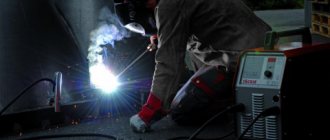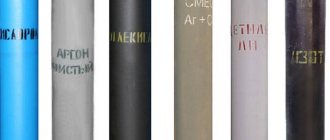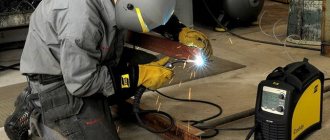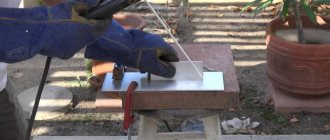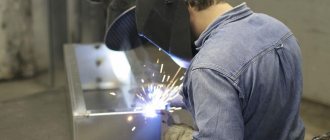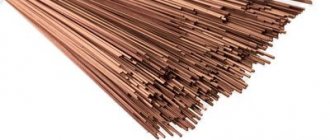For example, if after a long assembly of segments of the structure being welded, it falls apart from contact with the electrode or the welding is performed unsatisfactorily, then a lot of time will need to be spent on restoration operations. To prevent annoying situations and make the specialist’s work easier, additional devices were invented - magnets for welding.
Purposes of use
Magnetic fasteners are used to achieve the following purposes:
- Convenient fastening of parts and simplification of their installation;
- Correct positioning of the planes to be welded;
- Fast assembly of structures;
- Setting certain angles for connected products;
- Accurate and precise welding to avoid gross mistakes;
- An effective replacement for bulky clamps and clamps.
Welding magnets allow you to adjust the fastening and assembly of elements in accordance with operating conditions. They have an adhesive force of 10 to 50 kilograms and make it possible to work with both shaped products and sheet metal. The main advantages of such devices are such important factors as reducing the period for preparing products for welding and reducing the labor intensity of the work process.
Types of fastenings
If the structure after assembly falls apart after the slightest load, it will be a shame, because time and materials have been wasted. After this, all that remains is to get to work again.
The second option for poor preparation is improper welding . Let's assume that the element was welded differently: it changed its place when the metal cooled or changed its shape. This is much more difficult to fix.
It is to avoid such bad situations that special devices have been created that greatly facilitate welding and preparation for it - a switchable magnet for the welder. Since there is a lot of work to be done, the fastenings are grouped into several types:
Installation. They can be considered basic devices - they help to correctly outline and install the necessary elements.- Fastening devices. Reliably fix the elements in the required position.
- Fastening and installation. At the same time, they help install and secure parts in the required positions.
- Clamps. Used for fastening metal parts.
- Clamps. It's simple - if the parts are small, it's easier to use them rather than other bulky devices.
- Spacers. Helps align parts.
Types of magnets for welding
The main task of welding work is to create a seam whose characteristics are not inferior to the quality of the material of the parts being joined. To achieve decent performance during the work process, it is necessary to use various types of devices and devices.
Here are 7 of the most popular ones:
- Magnetic corners. This device is a structure of two metal plates and a magnet between them. A round hole is cut in the middle of the device. Magnet angles can be fixed or adjustable.
- Switchable magnets. This fastener allows you to fix the parts to be connected using a magnetic field activator. After completing the welding operations, a device of this type can be removed with one turn of the switch. The magnet is quickly and easily cleaned of chips and metal particles.
- Clamps. A device of this type allows the elements to be welded to be pulled together. Its outer side is used as a fixing component, and its inner part as a clamping device. Using such a device is quite simple - the products to be connected are placed in a clamp and then tightened with a screw.
- Spacers. This is the simplest device that allows you to correct edge defects in assembled products. They are able to give parts the required shape and eliminate local imperfections. The principle of operation of the spacer is similar to the functioning of the clamp, but unlike the latter, it works not to tighten, but to unclench.
- Installation magnets. This device may have a monolithic form or have a complex design with the ability to change angles. It is designed to install working elements in a specific position. The parts to be connected are fixed in the required position and then welded into the finished product. One of its functions may be the ability to disable fasteners. After pressing the shutdown button, the magnets of the device reduce their impact, and the device can be easily moved to another location.
- Fastening devices. These devices are designed to fix the parts to be welded in the required position. This is done in order to prevent displacement or deformation of the products. Such devices include clamps, clamps and ties.
- Installation and fastening products. Devices of this kind carry out an integrated approach to installing parts to be welded in a certain position and their subsequent fastening. In this case, it is enough to place the products in the device and tighten them together using screws. Parts can be fastened in one or two planes. To make it convenient to remove the structure after welding, one of the fastening elements is made in the form of a rotating mechanism.
How to choose a magnetic angle for welding?
For simple amateur work, inexpensive standard designs of magnetic holders are quite suitable, but for complex professional work and production conditions, three-coordinate (when using cylinders) and tetrahedral squares are intended - made using ferritic heat-resistant magnets, they will provide the necessary power for confident fixation of a wide variety of weights and configurations of elements of the welded structure.
In any case, a high-quality magnetic angle for welding must be designed for heavy loads, have high tensile strength and be resistant to strong mechanical influences from the outside. A square with a certain power must firmly fix the structural elements corresponding to this power in weight and size - only in this case will the welder’s work be comfortable and safe.
To facilitate the dismantling of the magnetic fixing device, it is recommended to choose angles with switchable welding magnets - in this case, even one master can easily and quickly cope with complex work using a special switch (one or two to turn each edge on/off). Switchable corners are usually made from durable chrome plated sheets, and thanks to the working edges they are successfully used in working with various profiles.
Thus, it is recommended to choose a magnetic holder for welding work based on the expected joint angles of the parts, the weight of the tool, its size and power.
Characteristics of welding magnets
All magnetic devices involved in welding work can be divided into two types:
- Universal devices;
- Corner magnets for welding.
Universal devices have great functionality and are widely used in many industrial areas.
They are capable of connecting parts of flat, cylindrical and angular configurations at non-standard angles. Magnets allow you to fix the elements to be welded both in the horizontal and vertical planes. This is achieved by the ability to adjust the working angles of the magnet in a fairly wide range. The devices have good resistance to high temperatures and can withstand metal splashes. Thanks to the increased accuracy when installing parts, the welding seam is neat and of high quality. The use of universal devices allows you to expand the scope of a specialist’s activity and reduce labor costs for welding work.
The advantages include factors such as convenient positioning, ease of operation, good magnetic field strength and no effect on the quality of the welding arc. The disadvantages are a decent cost and the availability of these devices only in highly specialized retail outlets.
A magnet for angle welding is the most popular device among domestic specialists today. It is simple in design and has an affordable price. This device is designed to install and secure in the desired position metal segments used in the assembly and welding of various structural objects.
The square helps to quickly and reliably connect parts when performing operations with metal angles, profiles, pipes (round, rectangular) and sheet steel.
Magnets come in three forms:
- Arrow-shaped;
- Triangular;
- Hexagonal.
Advantages of magnetic mass holders
The principle of operation of the holder in the form of a magnet also extends to the so-called “ground”, which is directly connected to the workpiece during welding. Its use during electric welding work is quite justified, since it provides the welder with tangible benefits, expressed in the following:
- due to the use of a reliable, compact and quickly established contact, the operator’s freedom of action is noticeably increased;
- The magnetic corner weight holder is attached before welding begins, so that its installation does not require any outside assistance;
- the possibility of reliable and stable connection with almost any serviced surface;
- simplicity of the magnet design, which does not contain any complex built-in elements;
- the ability to withstand loads and stresses over a wide range of mechanical influences, which ensures sufficient fastening strength of metal structures;
- and, finally, a significant contact area with the workpiece, guaranteeing reliable closure with it during welding.
However, the method of fixing mass has its drawbacks. The main one is that it is inconvenient to install a magnet on small metal parts (on a rod or fittings, for example).
Another disadvantage of these undoubtedly convenient devices is the impossibility of using them when welding non-ferrous metals, because the magnet does not stick to them.
To all that has been said, it should be added that during welding, small metal shavings and other waste stick to the magnet, which are recommended to be cleaned off with a wire brush.
Taking into account these inconveniences, the use of such a mass is generally justified, since it gives concrete and tangible results.
Criterias of choice
Before purchasing a magnet for welding, you need to carefully analyze issues related to the mode of use of the device and the scope of its application. There is no need to overpay for a brand and buy an overly expensive device if it will be used rarely and not for professional purposes.
Therefore, when choosing a magnet, you must adhere to a number of simple rules:
- The better the quality of the device, the longer it will retain its technical characteristics. The magnet is located in close proximity to the welding zone, therefore it is constantly exposed to high temperatures, which systematically deteriorate its properties;
- The higher the field power, the wider the range of use of the device. Serious models of magnets are capable of holding parts weighing up to 35 kilograms;
- The higher the list of working angles, the more functional the device is. The most preferred magnets are those with the following angles: 30, 45, 60, 75, 90 and 135 degrees;
- The greater the number of angles, the more varied the approach to welding work will be.
Magnetic devices have virtually no effect on the quality of the welding arc. But today there are still cheap models produced by Chinese manufacturers, the use of which can negatively affect the work process. You should refrain from purchasing these devices.
If funds allow, then it is worth taking a closer look at devices with a magnet activator. Today, the domestic market is represented by a fairly large number of these devices.
A switchable magnet for welding is an indispensable assistant for a professional in his daily work activities. It allows you to effectively perform welding work independently, during the absence of an auxiliary worker. But do not forget that if the wrong magnet is chosen or its quality is low, a situation may occur when the assembled structure collapses at the most inopportune moment, thereby causing irreparable damage to the work process.
Squares
One of the varieties of magnets for welding includes special angles that completely replace bulky clamps and provide fixation of parts at angles of 45, 90, 135 degrees.
There are many designs and variants of such magnets produced by different manufacturers. They differ not only in their working dimensions and mounting angles, but also in their adhesion strength.
The magnetic clamp or welding angle can have a variety of configurations, providing the ability to set the required mounting angle. Such magnets can have the following designs:
- ordinary squares, through which it is possible to set fixed angles determined by the profile of the workpieces;
- clamp-type fasteners with the ability to adjust the angle of fixation, ensuring their universal use as welding elements on structures of any degree of complexity;
- modern samples of squares with several fixed angles, also related to multifunctional tools and used in organizing complex welding work;
- angles with different clamping forces, designed for both massive elements of welded structures and small (compact) parts.
In addition to all of the above, a permanent or switchable magnet can be built into the fastening samples, allowing you to remove the product without any noticeable effort.
The cost of each magnet model is formed taking into account a number of indicators relating to the design used (the ability to set different angles, their adjustment and magnet power). It ranges from 300-400 rubles for a standard sample (800-900 rubles for a set of standard corners) to 3000-5000 rubles for special professional models.
Each magnetic welding holder has its own performance characteristics that determine its sales price. However, for those who are not “fixated” on branded products and want to save money on purchases, the option of making them yourself is always possible.
Homemade magnetic clamps
You can make a magnetic angle for welding with your own hands; it is not difficult, especially since there is more than enough information on the order of the operations performed.
Design
A magnetic fixture or device is typically made from two separate parts. First, there is the contact or point where the lead cable is secured to the holder. Secondly, it is the magnet itself, which can have different shapes and dimensions.
The two parts of the prefabricated product for welding are connected by means of a special fastening, ensuring their reliable coupling. In this case, special attention is paid to the total weight, which should not exceed a certain value.
Thus, magnetic welding triangles from ESAB have a total weight of about 850 grams and guarantee ease of handling.
Taking into account the design features of welding magnets, you can begin to directly assemble them.
Self-production
You will need a fairly “strong” magnet, which can be used as the base of a powerful speaker that has become unusable. Next, you will need to find two sets of thick washers that fit them in size.
And finally, you should stock up on additional fasteners (bolt and nut) necessary to connect the welded cable clamp. When assembling the system, first drill a hole for the bolt in one of the washers (which will serve as a contact pad). After this, it is inserted into the workpiece and welded.
The head of the fastening bolt is ground down with a file to the thickness of the washer itself (flush with the contact plane).
After welding, the mushroom-shaped structure is carefully cleaned with a file, and then a magnet from the speaker is threaded onto it. To complete the work, a second washer is attached to the protruding threaded rod and the end of the cable is secured here, and then the entire structure is tightened with a nut.
At the end of the review, let us draw your attention to the fact that, despite the significant savings when making a welding holder yourself, branded magnets are still more reliable and durable.
